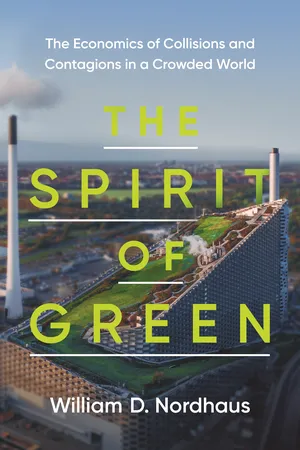
The Spirit of Green
The Economics of Collisions and Contagions in a Crowded World
- English
- ePUB (mobile friendly)
- Available on iOS & Android
The Spirit of Green
The Economics of Collisions and Contagions in a Crowded World
About this book
From a Nobel Prize–winning pioneer in environmental economics, an innovative account of how and why "green thinking" could cure many of the world's most serious problems—from global warming to pandemics
Solving the world's biggest problems—from climate catastrophe and pandemics to wildfires and corporate malfeasance—requires, more than anything else, coming up with new ways to manage the powerful interactions that surround us. For carbon emissions and other environmental damage, this means ensuring that those responsible pay their full costs rather than continuing to pass them along to others, including future generations. In The Spirit of Green, Nobel Prize–winning economist William Nordhaus describes a new way of green thinking that would help us overcome our biggest challenges without sacrificing economic prosperity, in large part by accounting for the spillover costs of economic collisions.
In a discussion that ranges from the history of the environmental movement to the Green New Deal, Nordhaus explains how the spirit of green thinking provides a compelling and hopeful new perspective on modern life. At the heart of green thinking is a recognition that the globalized world is shaped not by isolated individuals but rather by innumerable interactions inside and outside the economy. He shows how rethinking economic efficiency, sustainability, politics, profits, taxes, individual ethics, corporate social responsibility, finance, and more would improve the effectiveness and equity of our society. And he offers specific solutions—on how to price carbon, how to pursue low-carbon technologies, how to design an efficient tax system, and how to foster international cooperation through climate clubs.
The result is a groundbreaking new vision of how we can have our environment and our economy too.
Frequently asked questions
- Essential is ideal for learners and professionals who enjoy exploring a wide range of subjects. Access the Essential Library with 800,000+ trusted titles and best-sellers across business, personal growth, and the humanities. Includes unlimited reading time and Standard Read Aloud voice.
- Complete: Perfect for advanced learners and researchers needing full, unrestricted access. Unlock 1.4M+ books across hundreds of subjects, including academic and specialized titles. The Complete Plan also includes advanced features like Premium Read Aloud and Research Assistant.
Please note we cannot support devices running on iOS 13 and Android 7 or earlier. Learn more about using the app.
Information
1
Preface
Blueprint for a Green Planet
PART I
Foundations of a Green Society
2
Green History
Pinchot, Muir, and the Founding of American Environmentalism
The fundamental idea in forestry is that of perpetuation by wise use—that is, of making the forest yield the best service possible at present in a way that its usefulness in the future will not be diminished, but rather increased.
Memories may escape the action of will, may sleep a long time, but when stirred by the right influence, though that influence be light as a shadow, they flash into full stature and life with everything in place.… I beheld the Gulf of Mexico stretching away unbounded, except by the sky. What dreams and speculative matter for t...
Table of contents
- Cover Page
- Title Page
- Copyright Page
- Contents
- 1. Preface
- Part I. Foundations of a Green Society
- Part II. Sustainability in a Perilous World
- Part III. Behavioralism and Green Politics
- Part IV. Green Across the Social and Economic Landscape
- Part V. Global Green
- Part VI. Critiques and Final Reflections
- Notes
- Index